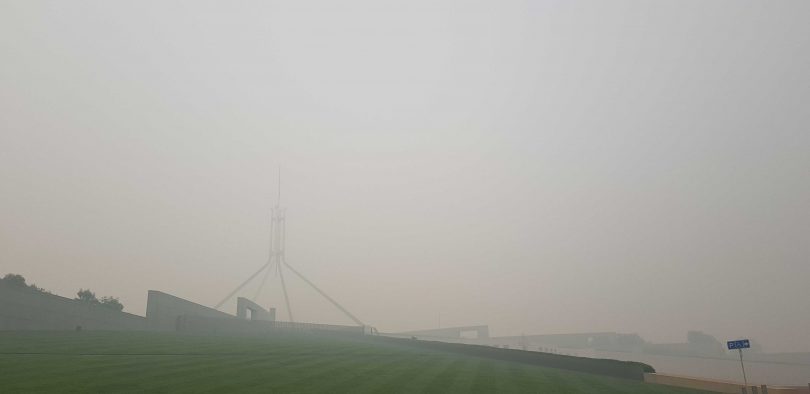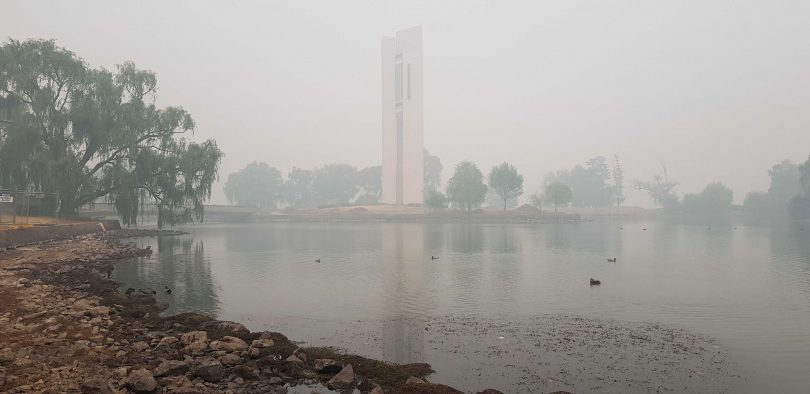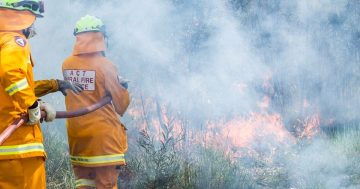
Parliament House in the big smoke on New Year’s Day. Photo: File.
Telling a story has always been a powerful way to pass on information or clear the air, particularly with children. And a new project from the Australian National University aims to do just that with a multi-language children’s book about last summer’s bushfire smoke that cast a pall over the Canberra region.
The project was born out of ANU researchers hastily producing a community trauma toolkit during the Black Summer fires and realising that not all the information was getting through because of language barriers or because it wasn’t in a family-friendly form.
Now they are calling on parents, carers and educators of children aged six to 12 years to help produce a children’s storybook about bushfire smoke and health.
They are hoping to service vulnerable groups and are pooling resources and expertise from across the ANU campus, including the ANU Centre for Arab and Islamic Studies, ANU Medical School, ANU National Centre for Epidemiology and Population Health, and the ANU Population Health Exchange.
“People who have experienced the last bushfire season with children have a story to tell. We want to hear it and shape it into a story we can share with everyone,” said Professor Sotiris Vardoulakis from the ANU Research School of Population Health.
“Last summer was a whole new world for children. Parents may have been stressed, people were wearing face masks and young people couldn’t go out to play. All those changes are difficult to internalise and digest.
“We want this book to be ready for the next summer season to help children cope better with these kinds of situations.”
The project is calling for contributors on a voluntary basis. Interviews will take 10 to 15 minutes and can be done in person, by phone, or online via Skype or Zoom.
Researchers say they will be better able to develop materials and health messages after speaking with people who have experienced the “black summer”.
“During the summer fires, a lot of narrative and visual information was made available for the general adult population. This included health messages and environmental data related to the extreme smoke haze that blanketed ACT, NSW and Victoria over several weeks,” Professor Vardoulakis said.
“In contrast, there was very little information specifically tailored for young children, immigrants, refugees and other vulnerable groups, which were exposed to the smoke and had to alter their daily behaviour to protect their health.”

Smoke on the water shrouded the Carillon last January. Photo: File.
Nicola Palfrey, Director of the Australian Child and Adolescent Trauma, Loss and Grief Network, said the storybook would be a chance for children to discuss what they have been through.
”We all think we’re good at knowing what our kids have gone through but all the research indicates that we’re terrible at it because they don’t share it with us, particularly if it’s really stressful, they keep their concerns to themselves,” she said.
Ms Palfrey said it was important to talk to children but parents were often anxious about how to do it.
”By delivering the message in a storybook you’re setting up the environment you want to share information in. Sitting with their children, a story has a beginning and an end and allows for conversation and connection. You can give the information but it doesn’t have to go too deep,” she said.
Ms Palfrey said children need to know what is going on, how they can help and importantly that the adults have the situation in hand.
”If they know what they can do, the adults can deal with the rest,” she said.
The researchers see the storybook project as a model for explaining other traumatic events such as the ongoing pandemic.
The project may be broadened beyond the chosen languages but they are some of the most common and the Centre for Arab and Islamic Studies will be able to provide translators.
The story will be a picture book and researchers will also consider artistic contributions.
“To make a useful book, it is important to get the visuals and the story right. This is why we need help from educators and parents, who know these kids best,” according to Dr Erin Walsh from the ANU Research School of Population Health.
Associate Professor Karima Laachir, Director of the ANU Centre for Arab and Islamic Studies, said: “The children’s storybook project on bushfire smoke will be inclusive of Australia’s multicultural society and sensitive to the needs of various multilingual communities around the country. It will appeal to children and parents from diverse backgrounds.”
To learn more go to the ANU website.












